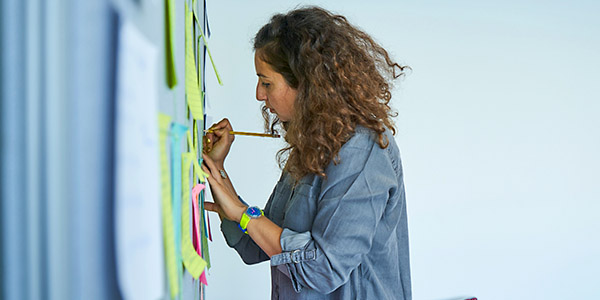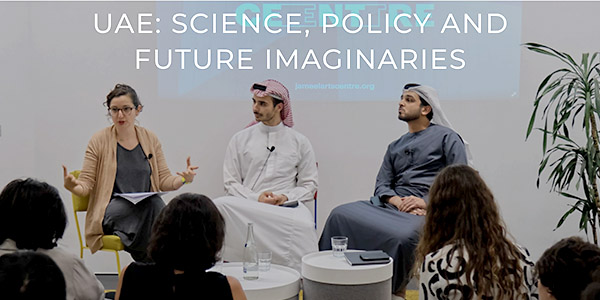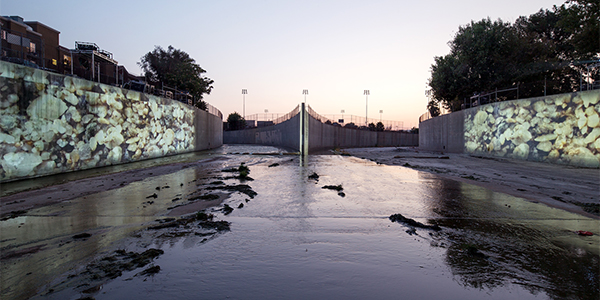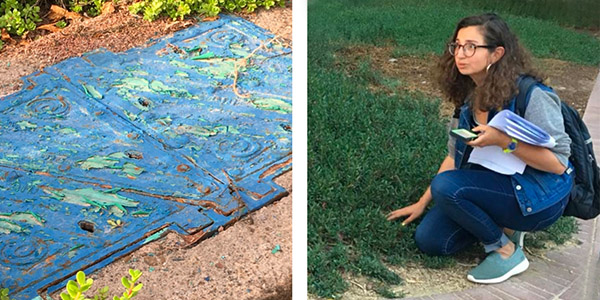SOLVING CLIMATE | HUMANISTIC PERSPECTIVES FROM MIT
Nadia Christidi | Imaginative Capacities
Christidi focuses on three cities and the role that the arts play in the ability of planning institutions to imagine and plan for possible futures.

Nadia Christidi, PhD student, MIT HASTS (History; Anthropology; Science, Technology, and Society)
"As climate change gets underway, we’re seeing a lot more emphasis on adaptation, and imagination is key to adapting to a set of totally different circumstances. This belief has led me to explore the 'imaginative capacities' of planning institutions, the impact of popular culture imaginaries on our preparations for the future, and the role that creative practitioners can play in expanding our imaginative possibilities."
— Nadia Christidi, PhD Student, MIT HASTS program
Full Series Solving Climate | Humanistic Perspectives from MIT
Also See Fast Forward: MIT's Climate Action Plan for the Decade
In this ongoing series, MIT faculty, students, and alumni in the humanistic fields share perspectives that are significant for solving climate change and mitigating its myriad social and ecological impacts. Nadia Christidi is a PhD student in MIT HASTS, a program that combines research in History, Anthropology, and Science, Technology, and Society. Her dissertation examines how cities that face water supply challenges are imagining, planning, and preparing for the future of water. Christidi has a particular interest in the roles that art, design, and architecture are playing in that future imagining and future planning process. She is the recipient of a J-WAFS Fellowship for Water Solutions for 2020-21. MIT SHASS Communications recently spoke with Christidi about her research and her vision for
• • •
Q: There are many sensible approaches to addressing the climate crisis. Increasingly, it looks as if we’ll need all of them. What perspectives from the HASTS fields are significant for addressing climate change and its ecological and social impacts?
Christidi: My research focuses on how three cities that face water supply challenges are imagining, planning, and preparing for the future of water. The three cities I focus on are Los Angeles, Dubai, and Cape Town. Water is one of the key issues when it comes to adapting to climate change and my work tries to understand how climate change impacts are understood and adaptation policies developed.
My approach to climate change and adaptation brings together various disciplines — history, anthropology, science and technology studies, and visual cultures; each of these helps me see and elucidates very particular aspects of climate change.
I think history reminds us that our ways of being and systems are historically constructed rather than given, inevitable, or natural, and that there is an alternative. Anthropology elucidates that while we may all talk about "climate change," what is meant by it, how it is understood and experienced, and how it is dealt with as a problem will differ from place to place; climate change is as much a social and cultural phenomenon and experience as it is a scientific or environmental one, as much a global issue as it is a local one. The social, cultural, and local, anthropology reminds us, have to be factored into meaningful policy.
Science and technology studies sheds light on the various communities involved in developing climate change knowledge; the role that their investments, stakes, and interests play; and the translation between science and policy that needs to happen for scientifically-informed policy to emerge. The STS perspective also points out that science is one of many systems for understanding climate change and that there may be other valid, useful worldviews from which we can learn.
And finally, visual cultures underscore how pop cultural and visual references, symbols, and imagery shape imaginaries and expectations of climate change, including scientific ones, and sometimes open up or foreclose pathways to action.

Christidi public conversation: Climate Change in the UAE: Science, Policy, and Future Imaginaries 2019.
"What are some likely scenarios for climate change in the UAE? How is the UAE prioritising the likelihood of these various scenarios and preparing for them simultaneously? What might a climate change-ready UAE look like and what needs to happen for climate change readiness to be enhanced?" About the project
Q: What pathways of thought and action do you personally think might be most fruitful for alleviating climate change and its impacts — and for forging a more sustainable future?
Christidi: I think we are going to need a lot of imagination going forward. As climate change gets underway, we’re seeing a lot more emphasis on adaptation, and imagination is key to adapting to a set of totally different circumstances.
This belief has led me to explore the "imaginative capacities" of planning institutions, the impact of popular culture imaginaries, from the utopian to the dystopian, on our preparations for the future, and the role that creative practitioners — including artists, architects, and designers — can play in expanding our imaginative possibilities.
One of my interlocutors aptly uses the phrase "crisis of imagination" to describe the present. In order for the necessary imagination work to take place, we must take seriously different actors as sources of knowledge, expertise, and perspectives, and make the process of imagining and planning more inclusive.
Partly, my work considers how creative practitioners are imagining climate change and the future of water and the alternative knowledge or perspectives they can offer. Most of the works that I look at involve collaborations between artists/architects, scientists, engineers, and/or policy-makers. They see artists contributing to science or transforming urban space or impacting policy.
For instance, the UAE pavilion at the Venice Architecture Biennale, Wetland, will unveil a locally-produced salt-based building material as an alternative to cement. Developed by Dubai-based architects Wael Al Awar and Kenichi Teramoto, the pavilion tackles the issues of brine — a salty byproduct of desalination, which is the country’s main source of potable water — and the carbon footprint of cement use in Dubai’s robust construction industry.
Inspired by historical examples of salt architecture and by the natural architectures of local salt flat ecosystems, the architects worked with scientists from NYU Abu Dhabi to develop the material. Such work shows how interdisciplinary collaborations with creative practitioners can not only advance the sciences, but also reimagine established industries and practices, and develop innovative approaches to the carbon emissions problem.

From UnderLA, a public arts project by Peggy Weil and Refik Anadol commissioned by the City of Los Angeles; Photo by Panic Studio. The installation projects the layers of soil and sedimentation under the river onto the banks of the Los Angeles River. Photo used with kind permission of Peggy Weil.
Peggy Weil, an artist based in Los Angeles, rethinks landscape as a genre in our climate changed present. Holding that the traditional horizontal format of the landscape is no longer representative, she develops “underscapes,” where she films the length of ice cores or aquifers, and “overscapes,” which involve studies of the air, as portraits of the earth. These ‘scapes’ argue for a need to reperceive our surroundings in order to more fully understand how we have chemically, hydrogeologically, and climatically transformed them.
Peggy and I have talked extensively about how important "re-perceiving" will be for encouraging behavior changes and generating economic and political support for the work of water managers and policy makers as well as the role of the arts in driving this "re-perception."
Q: What dimensions of the emerging climate crisis affect you most deeply — causing uncertainty, and/or altering the ways you think about the present and the future? When you confront an issue as formidable as climate change, what gives you hope?
Christidi: I think one dimension of the climate crisis I find especially disturbing is its configuration at times and in certain places as an economic opportunity, where new devastating environmental conditions are taken to be opportunities for innovation and technological development that will enable economic growth.
This becomes especially compelling in times of economic deceleration or as the specter of the end of oil grows stronger. But we need to ask: economic growth for whom, at what costs, and with what effects? And is growth what we really need?
I don’t think that the economy should be pitted against the environment; I am a total believer in sustainability as an issue that must encompass the economic, social, and environmental. But the real problems are with economic distribution rather than growth and the promise of unlimited growth — as further stoked by renewables — is a fallacy/fantasy.
I tend to agree with journalist Naomi Klein that the market, green or not, isn’t going to solve climate change challenges because we need more than just a technofix; we need policy and behavioral changes and new investment directions, many of which go against established economic arrangements and priorities. Locally produced salt-based building materials are a good start but not enough.

L: Learning to read grates, manholes, and other signs R: Christidi examining sea purslane, a replacement for water-intensive grass
"Watertight: A Guided Tour of Jebel Ali Village" was a public event organized within the framework of an Art Jameel arts research and writing residency that explored how to see and read water supply and transmission infrastructures in the city of Dubai.
Some of the most challenging and consequential imaginative work we will have to do will be on the social front; this will entail reconsidering some things we take for granted. I love theorist Frederic Jameson’s suggestion that “it is easier to imagine the end of the world than it is to imagine the end of capitalism,” as well as Mike Fisher’s concept of “capitalist realism,” which captures the ideological underpinnings of that worldview.
The privatization of water is one of the scariest intensifying developments in my mind, especially given anticipated climate change effects, but I take some reassurance from projects that aim to counter such trends. One of the promising architectural proposals I've studied in Los Angeles is by Stephanie Newcomb. Stephanie’s work, Coopelluvia, aims to complement stormwater capture projects developed by governmental entities in LA county on public land and that form a major prong of the City of LA’s water planning strategy; it explores the possibility of turning stormwater captured in side setback spaces between private properties into a communal water resource in the low income, predominantly Latino neighborhoods of Pacoima and Arletta in the San Fernando Valley.
Stephanie’s proposed intervention blurs the boundary between public and private and empowers marginalized communities through developing communal resource management systems with multiple environmental and social benefits. Her work is guided by theories of the commons rather than privatization and market-oriented solutions — and I think such projects and theories hold a lot of promise for facilitating the kinds of radical change we need.
Suggested links
Full Series Solving Climate | Humanistic Perspectives from MIT
Also See Fast Forward: MIT's Climate Action Plan for the Decade
Nadia Christidi website
Christidi: Fluid Futures: Op Ed on Art and Climate Change Policy
Christidi | webpage at MIT HASTS
MIT HASTS Program
MIT Anthropology
MIT Program in Science, Technology and Society
Projects cited in the Commentary
Underscape and Overscape | by Peggy Weil
An extension of traditional landscape portraiture to include the areas beneath our feet and above our heads
Under LA | by Peggy Weil and Refik Anadol
Commissioned by the City of Los Angeles; Anadol and Weil’s UnderLA: First Street Bridge and The Origin of the LA River, is a visual descent below the surface of Los Angeles via scrolling images of lithologic soil samples. At one thousand feet the photographed samples represent material dating over a million years, at fourteen hundred feet as far back as 2.5 million years to the Pliocene Epoch.
Coopelluvia: Facilitating Urban Water Commoning | by Stephanie Newcomb
"With current city and county stormwater capture plans fo-cusing on public land, this investigation focuses on possibili-ties of water collectivization between private properties. Water commoning is an opportunity for a new method of urban water stewardship: one that empowers individuals and neighborhoods to engage directly with building and maintain-ing local water supplies."
Wetland
For its tenth participation in the Venice Architecture Biennale, the National Pavilion of the United Arab Emirates is conducting groundbreaking research into an environmentally-friendly cement alternative inspired by the UAE’s Sabkhas (salt flats) and created from salts and minerals extracted from waste brine.
Series prepared by SHASS Communications
Office of Dean Melissa Nobles
Editorial and Design Director: Emily Hiestand
Co-Editor: Kathryn O'Neill
Published 20 April 2021